Roughly 25 years ago, Toyota introduced the Prius to the American market, marking its entry into the hybrid vehicle segment. While initially known for its distinctive, often polarizing, shape and a somewhat “uncool” image, the Prius was an instant sales success, selling nearly a quarter-million units annually in the US.
Fast forward to a couple of years ago, Toyota unveiled an all-new, fifth-generation Prius. This radical redesign shed its old skin, embracing a sleek, sexy, and far more powerful form. For 2025, Toyota is adding a new flavor to the lineup: the Prius Nightshade. This trim essentially takes the well-equipped XLE model and injects a dose of sinister style with black wheels, black accents, and a darker vibe. My test car arrived in a unique color called “Karashi,” which is Japanese for spicy brown mustard – a fitting shade for a car that’s anything but bland.
For those seeking a fuel-efficient commuter car with available all-wheel drive, promising over 50 MPG, the big question is: How does the latest 2025 Toyota Prius Nightshade stack up? Join me as we explore every facet of this transformed hybrid.
Powertrain & Performance: More Punch, More Traction
Under the hood, the fifth-generation Prius received a significant power boost, making it the most powerful non-plug-in Prius Toyota has ever produced. While the engine bay isn’t the prettiest (surprisingly lacking an engine cover), it houses Toyota’s fifth generation of the Hybrid Synergy Drive system.
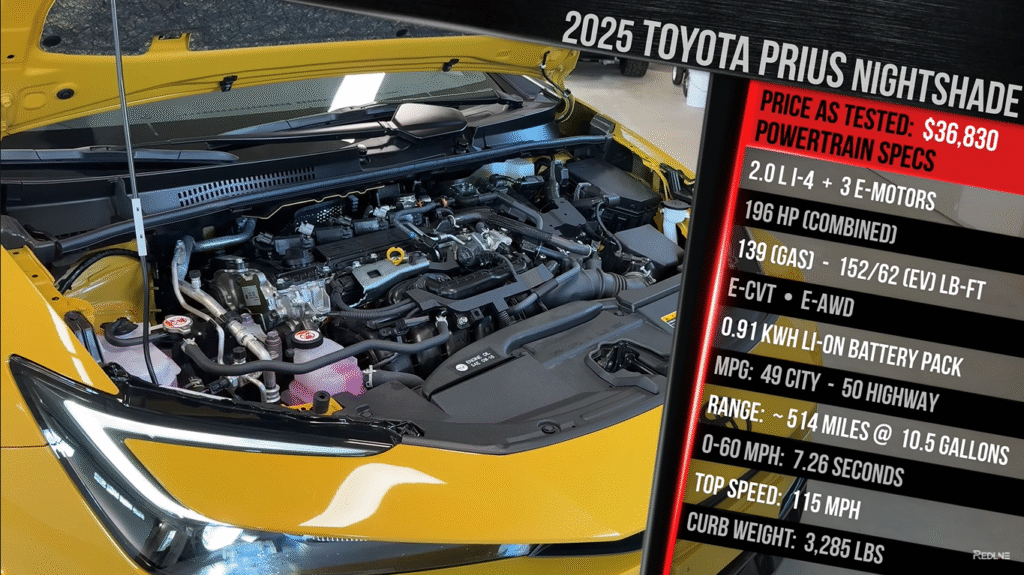
This particular model, the all-wheel drive (AWD) version, combines a 2.0-liter naturally aspirated, direct and port-injected four-cylinder engine with variable valve timing technology. It’s supplemented by three electric motors: two at the front and a separate e-axle at the back. This setup gives the vehicle a combined total of 196 horsepower, a slight increase of 2 horsepower over the front-wheel drive version. Toyota does not provide a combined torque figure for its hybrid powertrains. Power is sent through an electronic CVT (Continuously Variable Transmission).
The electronic all-wheel drive is an on-demand system. It lacks a mechanical linkage from the engine to the rear axle, which is powered exclusively by a 40-horsepower rear electric motor. The electric motors draw power from a compact 0.91 kWh lithium-ion battery pack. This is not the plug-in hybrid (Prius Prime) model.
Toyota claims the AWD model can go from 0 to 60 mph in around 7 seconds. In my testing, I achieved a quickest time of 7.26 seconds, with another run at 7.35 seconds. While slightly slower than the front-wheel drive version (which I previously tested at 6.9 seconds) and its main rival, the Civic Hybrid (around 6.4 seconds), this is a massive improvement over the previous generation Prius’s notorious 10-second 0-60 mph time. The car feels quite peppy, though the 4-cylinder engine can be a bit noisy under hard acceleration.
Exterior Design: Sleek, Sporty, and Striking
The fifth-generation Prius represents a radical design departure. Toyota made this car significantly more attractive than its predecessor by making it wider, lower, and longer. It now boasts a much sleeker, more aerodynamic, and desirable shape, shedding its former “clown car” image.
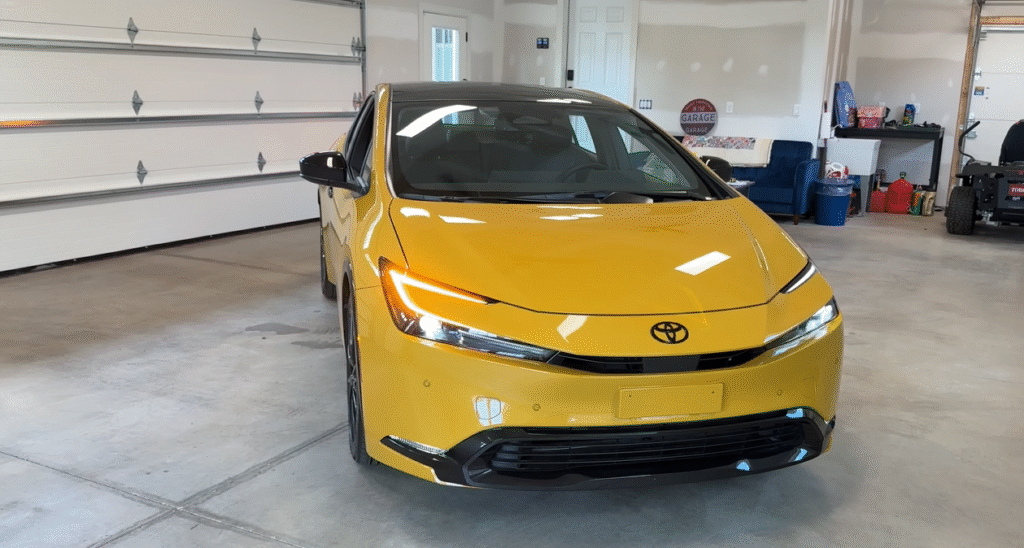
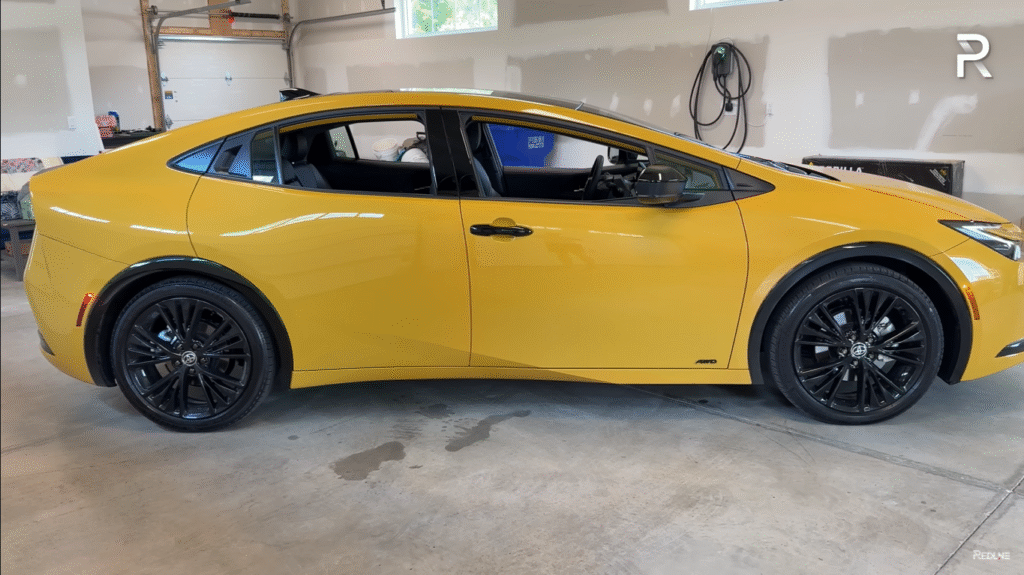
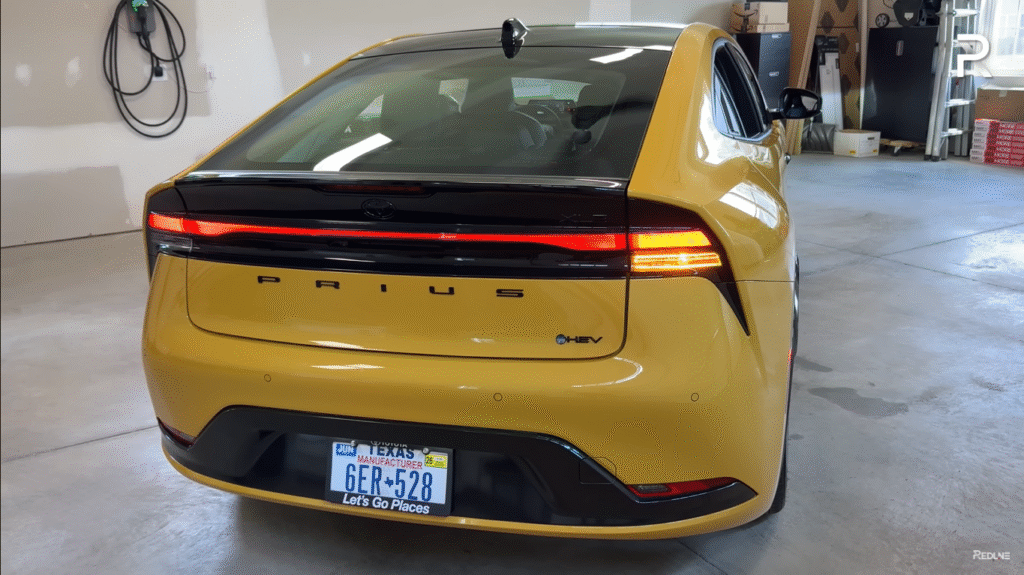
- Front End: The Prius was the first to showcase Toyota’s “hammerhead” design language. This includes sleek LED daytime running lights, LED turn signals, and LED projector low and high beams. A subtle male slit in the front fascia functions as a grill for engine cooling, supplemented by additional functional openings below. The Nightshade package blacks out the lower front splitter, which pairs interestingly with the Karashi yellow exterior. Black badging for the Toyota logo further enhances the dark, sporty vibe.
- Side Profile: As a compact sedan, the Prius competes directly with vehicles like the Honda Civic hatchback hybrid. With a 108.1-inch wheelbase and 181.1-inch overall length, it’s slightly longer than the current Civic Hybrid. The steeply raked windshield contributes to the Prius’s very slippery 0.27 drag coefficient, though it slightly compromises interior headroom. The Nightshade package adds unique 19-inch gloss black alloy wheels with a double five-spoke design (riding on 195/50 R19 tires). These larger wheels, however, slightly lower the combined fuel economy compared to the LE trim with 17-inch wheels (from 52 MPG to 49 MPG for AWD). The Nightshade also features gloss black wheel arch trim and black mirrors. A subtle “AWD” badge on the lower front doors is the only exterior indicator of its all-wheel-drive capability.
- Rear Design: The rear door handle is cleverly hidden, creating a more sportback-like appearance. The sloping rear end contributes to the car’s sleek, sporty look. Full LED taillights with a trendy LED light bar span the width of the rear, boldly spelling out “Prius.” Blacked-out badging, including a subtle XLE badge (as the Nightshade is based on the XLE trim) and a “Beyond Zero” HEV badge, complete the look. Reverse lights are discreetly placed in the lower bumper.
Interior Design & Comfort: Modern Tech, Mixed Materials
Stepping inside, the 2025 Prius Nightshade offers a modern and comfortable cabin, though with some mixed material quality.
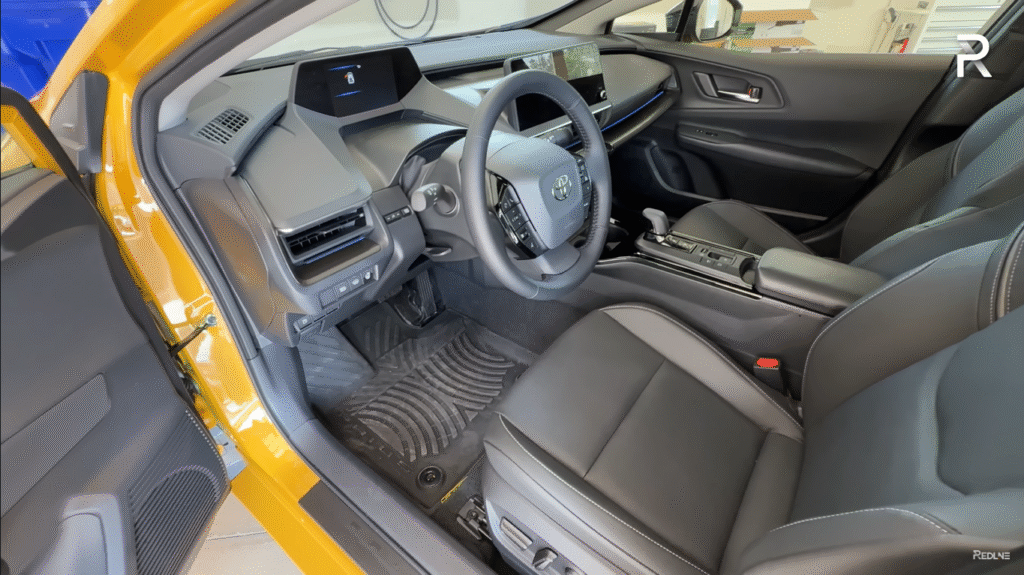
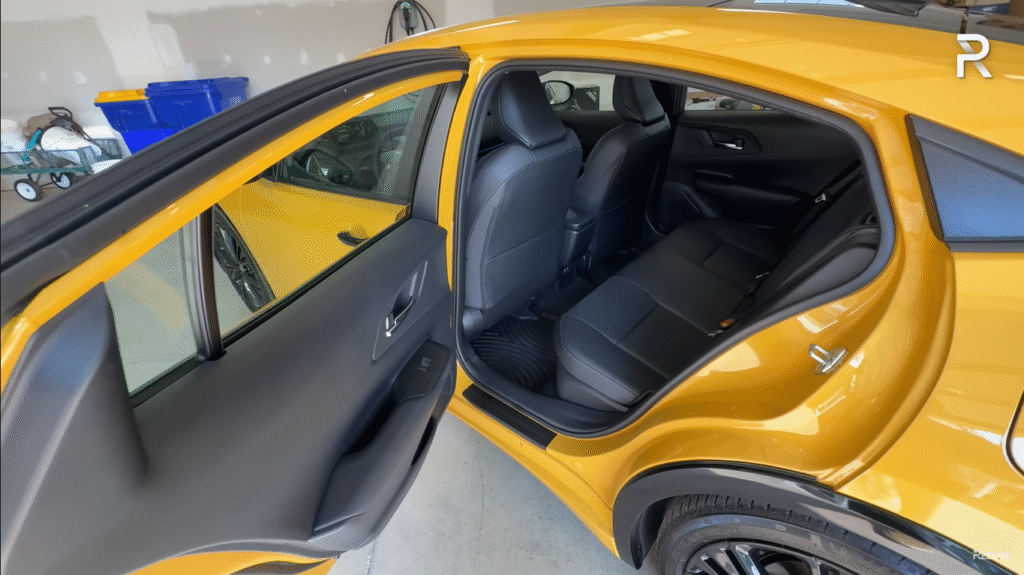
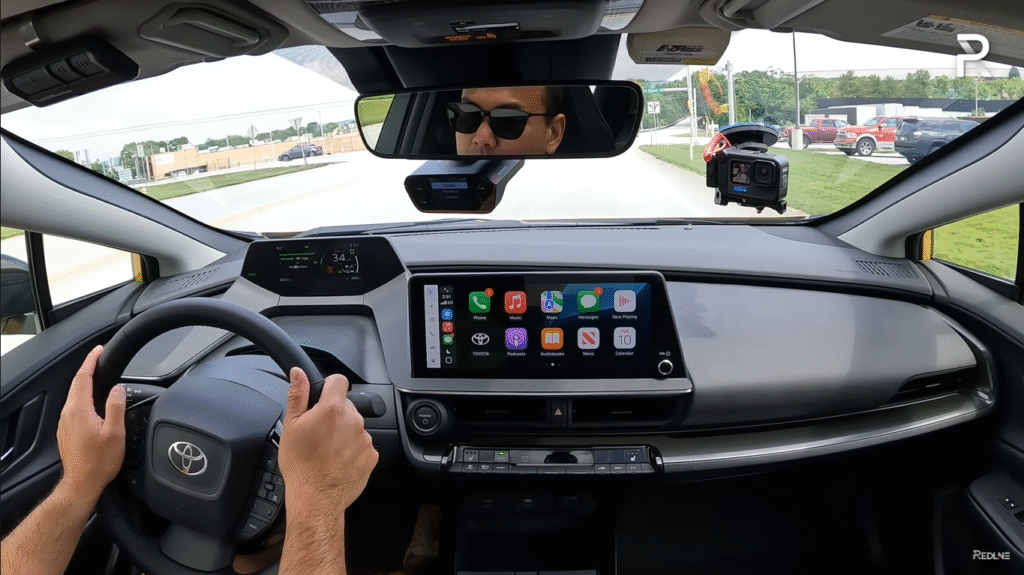
- Key Fob & Access: The latest Toyota intelligent access key fob is sleek, with limited buttons (lock, unlock, panic). Toyota also offers digital key functionality for an extra $275, allowing smartphone use as a key. The gloss black door handles on the Nightshade Edition feature touch-sensitive pads for locking and unlocking, accompanied by a new, more pleasant chime.
- Seating: The Nightshade Edition comes with a black SofTex (synthetic leather) interior with contrasting gray stitching and piping. The seats look and feel plush and high-quality for a fake leather. Both front seats are heated (three-level). The driver’s seat offers 10-way power adjustment, but memory functionality is limited to the top Limited trim. Ventilated seats are also exclusive to the Limited grade.
- Materials & Build: The door panels feature soft-touch injection-molded plastic with a padded area for elbows, though the door handle surround has a somewhat cheap feel. Window controls are one-touch for all four windows and illuminated. The dash features soft-touch plastic, but some areas, like the instrument panel binnacle, use hard-touch plastic with less appealing graining. The doors, unfortunately, have a “tiny, hollow sound” when closed, which doesn’t convey a premium feel.
- Infotainment & Displays: The test car features the larger 12.3-inch Toyota Audio Multimedia interface (an extra $750, standard on Limited), which includes wireless Apple CarPlay and Android Auto. Base Prius models get a smaller 8-inch display. The instrument panel has a 7-inch helper display positioned high, almost like a heads-up display. The steering wheel design is somewhat “ugly and dorky,” but features useful buttons for Toyota Safety Sense 3.0, audio, and cruise control. The horn sounds “pathetic and puny.”
- Climate Control: It offers single-zone automatic temperature control, lacking the dual-zone option found in some competitors like the Civic.
- Center Console: A storage area is present below the dash, with a hidden compartment, two USB-C ports, and a 12-volt outlet. The Nightshade uniquely features a fake carbon fiber-look plastic trim. The electronic gear shifter is intuitive but takes a moment to get used to. Drive mode selector offers Eco, Normal, Sport, and Custom modes. Other features include an electronic parking brake, EV mode (for short, light throttle electric-only driving), and a brake hold feature. The center console bin is deep and includes two more USB-C ports.
- Visibility & Headroom: The low roofline means taller drivers might need to duck when entering. Once inside, the low roofline and steeply raked windshield, combined with a long dash, compromise visibility slightly compared to the Civic. The view out of the back is also limited by the sloping rear window. While usable, it’s not as airy or spacious as the previous generation Prius.
Space & Practicality: Compact Yet Usable
The 2025 Prius is a compact sedan, and its design choices impact interior space.
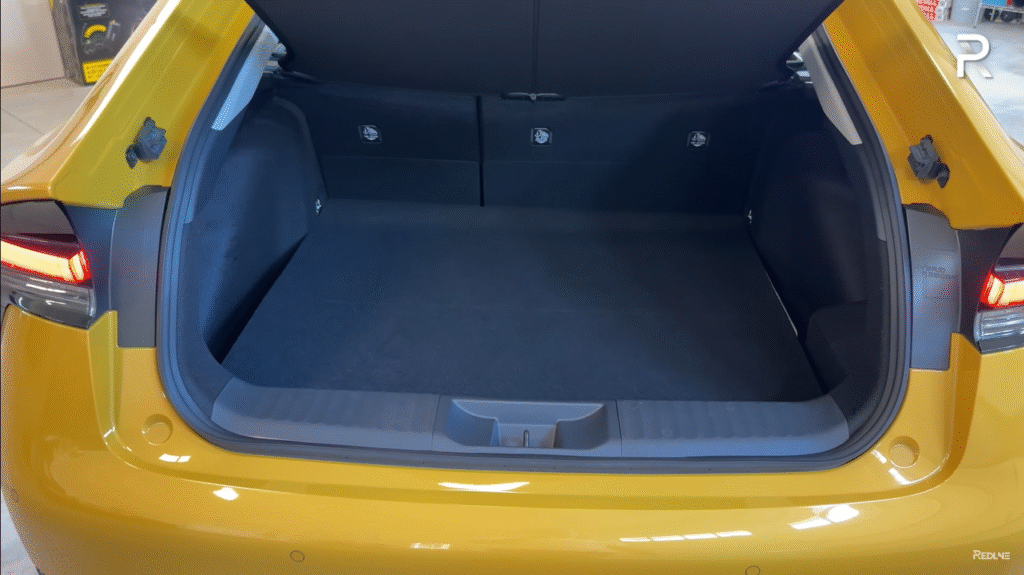
- Cargo Space: With the rear seats up, it offers 20.3 cubic feet of storage space. This is similar to the front-wheel drive versions, though the LE Prius (without the panoramic roof) offers more at around 27 cubic feet. There’s a small amount of underfloor storage, with space reserved for a larger battery in the plug-in hybrid model. The 12-volt battery is also hidden here. Toyota doesn’t quote cargo space with seats folded down, but it’s estimated to be around 40 cubic feet. The Civic Hybrid hatch offers slightly more (about 4 cubic feet more). The sloping rear end does impede maximum cargo capacity. A power liftgate is only available on the Limited trim.
- Rear Seat Space: The rear seat is “definitely not huge.” Legroom is 34.8 inches, which is about 3 inches less than the Civic hatchback and sedan. Headroom is also compromised, losing about an inch compared to the previous generation. Material quality in the back is hard-touch plastic. While usable for average-sized adults, it feels tighter, especially with the low roofline. It includes two USB-C charging ports but no rear seat air vents (even on the Limited trim). Heated rear seats are only available on the Limited. An armrest with two cup holders folds down.
For those needing more space in a Toyota hybrid, the Camry and RAV4 hybrids offer similar fuel efficiency with more interior room and power.
Driving Experience: Cushy Ride, Playful Handling
Driving the 2025 Prius reveals a well-tuned chassis that balances comfort with surprising agility.
- Ride Quality: The Prius offers a cushy ride, soaking up bumps nicely, even on the larger 19-inch wheels. Many will appreciate this comfortable ride quality.
- Handling & Steering: The steering is relatively quick and precise. The car feels playful in turns, showing surprising agility. While not as overtly sporty as the Civic Hybrid, the difference isn’t vast. The chassis feels capable, almost “begging for an even faster GR version.”
- Hybrid Transition: Toyota’s hybrid system excels here. The transition between gas and electric power is seamless, with very little delay. The CVT effectively manages engine revs for power delivery.
- Noise: A notable drawback is the cabin noise. The 4-cylinder engine can be a bit noisy, and there’s a fair amount of road noise entering the cabin, making it “a little bit of a racket.”
- AWD Performance: The AWD system primarily feels front-wheel drive biased until the front wheels slip, at which point the 40-horsepower rear axle engages. This provides added traction, an edge the Prius has over many competitors.
Fuel Economy: Real-World Efficiency King
The Prius’s core strength has always been fuel efficiency, and the 2025 model continues this legacy.
- EPA Ratings (AWD): Rated at 49 MPG in the city and 50 MPG on the highway, with a combined rating of around 49 MPG.
- Real-World MPG: In mostly city driving, I averaged 49.6 MPG, which is excellent. This is about 5 MPG less than the front-wheel drive model, confirming that the FWD version is more fuel-efficient. On the highway, I observed around 46 MPG.
- Range: With its 10.5-gallon fuel tank and combined rating, the cruising range is around 514 miles on a full tank of regular gas. Filling up this car is cheap, and it goes a long way, a key reason for its popularity.
- Comparison to Rival: The Prius is “far more fuel efficient in real-world testing versus the Civic Hybrid.” My last Civic Hybrid test yielded around 46 MPG city and 39 MPG highway, significantly below its EPA rating.
Top 10 Reasons to Buy the 2025 Toyota Prius Nightshade AWD
Top 5 Reasons to AVOID the 2025 Toyota Prius Nightshade AWD
Conclusion: A Transformed Hybrid for the Modern Commuter
The 2025 Toyota Prius Nightshade AWD is a testament to Toyota’s successful transformation of an icon. It has shed its “uncool” image for a sleek, sporty, and desirable design, coupled with a significant boost in power. The Nightshade trim adds a unique, aggressive aesthetic that certainly helps it stand out, even in a “Karashi” yellow.
While it has its minor drawbacks – such as interior material quality in some areas, cabin noise, and compromised rear seat space compared to rivals – its strengths are compelling. The seamless hybrid powertrain, surprisingly good handling, comfortable ride, and class-leading real-world fuel efficiency make it a highly attractive commuter. The availability of all-wheel drive further enhances its appeal, offering added traction that many competitors lack.
The Prius is no longer just a fuel-efficient appliance; it’s a stylish, peppy, and practical hybrid that’s anything but boring. If you’re looking for a fuel-efficient, AWD commuter with a bold new attitude, the 2025 Prius Nightshade is definitely worth checking out.
About the Author: Redline Reviews formally known as 2theRedline produces detailed and honest videos on all things automotive with special attention placed toward actual in-market consumers looking to purchase their next new vehicle
- Instagraminstagram.com/redline_reviews
- Facebookfacebook.com/liketheredline
- Source: 2025 Toyota Prius Nightshade
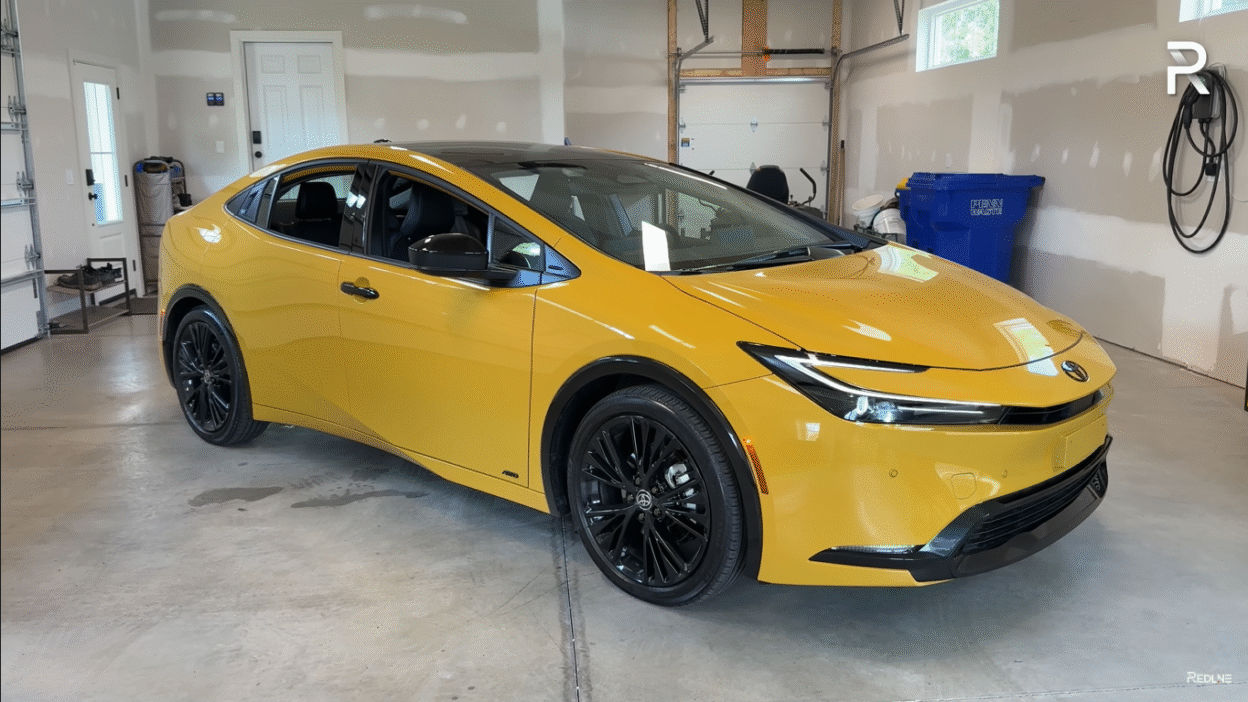
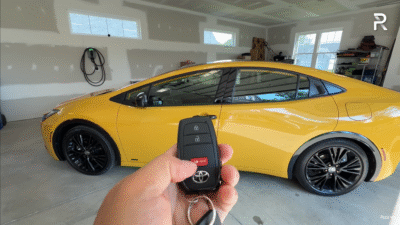
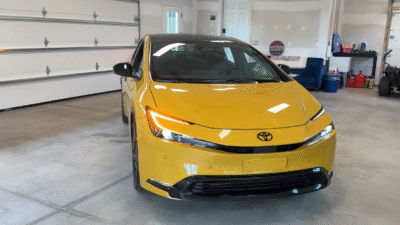
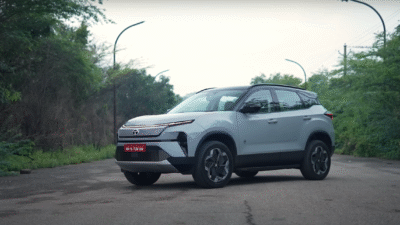
[…] a new vehicle that blends exceptional fuel economy with modern style and practical features, the 2025 Toyota Prius Nightshade AWD demands your attention. As an automotive reviewer, I’ve spent time behind the wheel, […]
[…] an automotive reviewer, my goal is to provide a balanced perspective. While the Nightshade AWD boasts many strengths, it also carries certain limitations that might make it less ideal for some […]